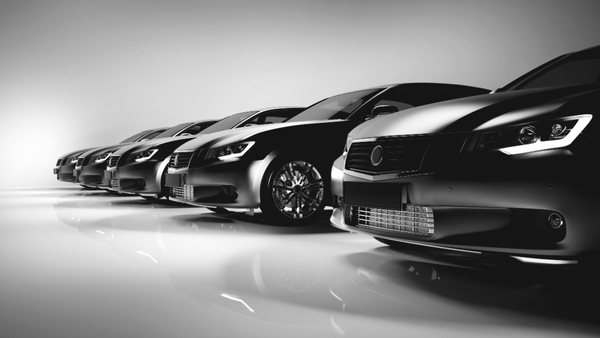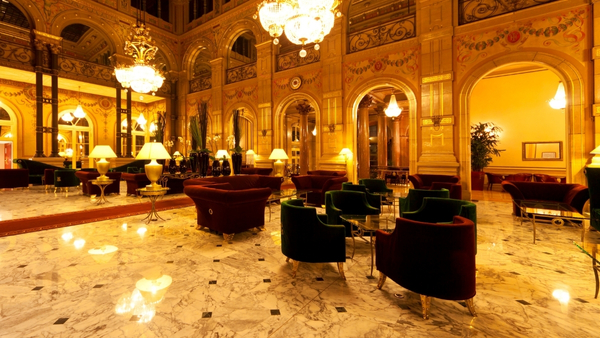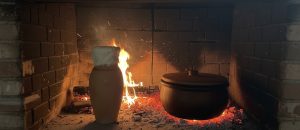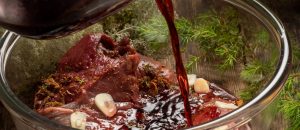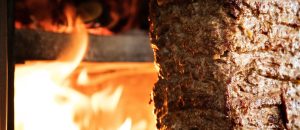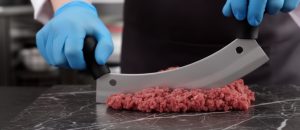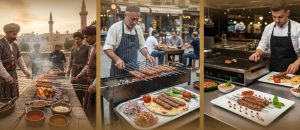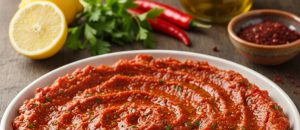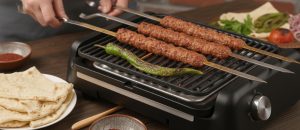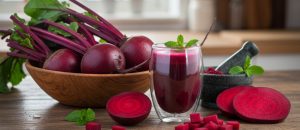The Döner Kebab, with its iconic vertical spit, is a culinary marvel that captivates not only with its taste but also with the ingenious science behind its cooking. More than just a visual spectacle, the vertical rotisserie employs a sophisticated interplay of physics and chemistry to transform layers of seasoned meat into a succulent, flavorful masterpiece. This in-depth article, a vital Cluster Content piece supporting our “Döner Kebab: Atlas of History and Varieties” Pillar Page, delves into the scientific principles that govern Döner Kebab preparation. For food scientists, culinary historians, and ambitious home chefs, we will explore the dynamics of heat transfer, the physics of self-basting fat, the chemical magic of the Maillard reaction, and the molecular changes in meat that contribute to its ideal tenderness and flavor. Join us as we uncover the scientific symphony that makes Döner Kebab a true masterpiece of culinary engineering.
The Vertical Revolution: Unpacking the Science of Döner Kebab Roasting
The vertical rotisserie, a revolutionary innovation in meat cooking, optimizes heat transfer, fat rendering, and flavor development through a sophisticated interplay of physical and chemical processes. It represents a significant advancement over traditional horizontal roasting, primarily by ensuring even cooking and continuous basting.
Beyond Simple Grilling: A Symphony of Physics and Chemistry
Cooking Döner Kebab is a complex scientific process involving radiant heat, fat rendering, protein denaturation, and the Maillard reaction, all orchestrated by the vertical rotation.
- Physics of Rotation: The continuous rotation ensures that all parts of the meat cone are exposed uniformly to the heat source, preventing one side from burning or drying out while another remains undercooked. This creates an even thermal profile.
- Chemistry of Browning: The high temperatures on the outer layer trigger crucial chemical reactions, such as the Maillard reaction and caramelization, which are responsible for the rich brown crust and complex flavor compounds.
- Fat Dynamics: The vertical orientation utilizes gravity. As fat from the upper layers melts, it drips down through the meat cone, self-basting the lower layers and keeping the entire mass succulent. This is a critical physical mechanism for moisture retention.
- Protein Transformation: Heat causes proteins in the meat to denature and coagulate, contributing to texture development. The slow, controlled cooking on the Döner spit ensures optimal protein transformation, resulting in tender meat.
Our Scientific Inquiry: Decoding Döner’s Flavor Dynamics
This article will embark on a scientific inquiry to decode the flavor dynamics of Döner Kebab, providing a molecular understanding of why it tastes so good.
- Heat Transfer: We will analyze how heat is transferred from the heating elements (gas flames or electric coils) to the rotating meat.
- Moisture Management: The role of fat rendering and self-basting in preventing dryness and maintaining succulence will be explained.
- Flavor Chemistry: We will delve into the Maillard reaction and other chemical processes that create the rich aromas and flavors.
- Texture Science: The molecular changes in meat proteins and connective tissues that contribute to the ideal tenderness and “bite” of Döner will be explored.
- Slicing Physics: The importance of thin, continuous slicing for both cooking efficiency and sensory experience will be highlighted.
Heat Transfer Dynamics: How the Vertical Grill Cooks Evenly
The vertical Döner grill is a masterclass in heat transfer, designed to cook a large, cylindrical mass of meat uniformly and efficiently. Understanding the balance of radiant and convective heat, combined with the continuous rotation, is key to appreciating how the Döner achieves its perfect, even doneness.
Radiant vs. Convective Heat: The Role of the Heating Element
The Döner grill primarily utilizes a combination of radiant and, to a lesser extent, convective heat to cook the meat.
- Radiant Heat: The primary heat source (typically gas burners or electric heating elements) emits radiant heat. This is similar to the heat you feel from a campfire or the sun. Radiant heat travels in waves and directly cooks the outer surface of the meat. It’s crucial for the intense searing and browning of the Döner.
- Convective Heat: As the air around the heating elements and the Döner becomes hot, it creates convective heat (heat transfer through fluid motion). This hot air circulates around the meat, contributing to its overall cooking, but its role is secondary to radiant heat for the direct searing.
- Targeted Heat: The design of the vertical grill often allows for adjustable heating elements, enabling the cook to target specific areas of the Döner cone, ensuring that all parts cook optimally as they reach the outer edge.
Rotational Cooking: Ensuring Uniformity and Preventing Drying
The continuous rotation of the Döner spit is not merely for aesthetics; it is a fundamental engineering principle that ensures uniform cooking and prevents the meat from drying out.
- Even Exposure: As the meat cone slowly rotates, every part of its exterior is periodically exposed to the direct radiant heat. This prevents any single side from overcooking or burning, ensuring a consistent brown crust around the entire Döner.
- Controlled Searing: The intermittent exposure to direct heat allows for gradual searing and the development of the Maillard reaction across the entire surface. If the Döner were static, one side would burn, and the other would remain uncooked.
- Moisture Preservation: The rotation, combined with the self-basting effect (discussed next), helps to seal in the meat’s internal moisture. By continually moving away from the direct, intense heat, the meat has moments to equalize its temperature and retain juices, preventing rapid dehydration.
- Continuous Carving: The rotation also facilitates continuous carving. As the outer layer cooks to perfection, it is sliced off, exposing the next layer to the heat, which then begins to cook. This continuous process ensures that only perfectly cooked meat is served, and the rest continues to cook optimally.
The Physics of Self-Basting: Fat Rendering and Moisture Retention
One of the most ingenious aspects of the Döner Kebab’s vertical roasting method is its inherent self-basting mechanism, a direct application of physics that is crucial for maintaining the meat’s succulence and flavor. This process involves the slow rendering of fat and its gravitational flow, ensuring that the entire meat cone remains moist and tender throughout the long cooking period.
Gravity’s Role: Fat Dripping and Meat Hydration
Gravity plays a pivotal role in Döner Kebab’s self-basting, allowing melting fat to continually hydrate and flavor the meat.
- Layered Construction: Döner is typically constructed by layering thin slices of seasoned meat (lamb, beef, or chicken) interspersed with layers of fat (often lamb tail fat or beef fat). This strategic layering is fundamental.
- Rendering and Dripping: As the outer layers of the Döner cone cook, the fat within these layers begins to melt or “render.” Due to the vertical orientation of the spit, this rendered fat, now in liquid form, is drawn downwards by gravity.
- Continuous Basting: Instead of dripping away and being lost, this hot, flavorful liquid fat slowly trickles down through the lower, uncooked or partially cooked layers of meat. This process continuously self-bastes the entire Döner cone.
- Moisture Retention: The basting fat helps to coat the meat, forming a barrier that reduces moisture loss through evaporation. It also penetrates the muscle fibers, replenishing lost moisture and ensuring the meat remains incredibly juicy from top to bottom, even after hours of cooking.
- Flavor Infusion: As the fat carries dissolved flavor compounds from the seasoning and the cooked meat, it redistributes these flavors throughout the entire cone, leading to a more homogenous and rich taste profile.
Preventing Dryness: The Importance of Fat Layers and Meat Composition
The strategic inclusion and layering of fat are not just for flavor; they are a critical scientific measure to prevent the Döner Kebab from drying out during its extended cooking time.
- Insulation: The fat layers act as a natural insulator, protecting the inner meat layers from the direct, intense heat and allowing them to cook more gently.
- Internal Moisture Source: As fat renders, it becomes a crucial internal source of moisture. Meat, especially leaner cuts, can quickly dry out. The fat ensures a continuous supply of liquid that keeps the proteins hydrated.
- Binding Agent: In some Döner preparations (especially those with ground meat layers or mixed meat types), the fat also acts as a binding agent, helping the meat stick together on the spit.
- Meat Composition: The initial composition of the Döner meat is thus vital. A Döner cone made entirely of very lean meat would quickly become dry and tough, even with vertical rotation. The deliberate addition of lamb tail fat (kuyruk yağı) or other animal fats, in precise ratios, is a scientific solution honed through centuries of culinary practice to ensure optimal succulence. This balance ensures that the Döner Kebab remains tender and juicy, bite after flavorful bite.
Chemical Transformations: Maillard Reaction and Flavor Development
The mesmerizing browning and the rich, complex aromas that emanate from a Döner Kebab spit are primarily the result of sophisticated chemical transformations, chief among them the Maillard reaction. This non-enzymatic browning process, along with caramelization and pyrolysis, is responsible for building the characteristic flavor profile and creating the irresistible crust that defines Döner Kebab.
Surface Browning: The Maillard Reaction’s Contribution to Crust and Aroma
The Maillard reaction is a complex series of chemical reactions between amino acids (from proteins) and reducing sugars (from carbohydrates) that occurs at high temperatures, creating hundreds of new flavor and aroma compounds and a desirable brown crust.
- Conditions: It typically begins at temperatures above 140°C (285°F). The dry heat on the Döner’s outer surface provides the ideal conditions for this reaction.
- Flavor Generation: The Maillard reaction is responsible for the vast majority of “cooked” flavors in meat, producing rich, savory, roasted, umami, and sometimes slightly sweet notes. These are the flavors we associate with perfectly browned meat.
- Crust Formation: As the outer layer of the Döner undergoes the Maillard reaction, it develops a delicious, slightly crispy brown crust. This crust is highly flavorful and provides a textural contrast to the tender interior meat.
- Aroma Compounds: The hundreds of compounds created during Maillard reactions contribute to the highly appealing aroma of cooking Döner, drawing customers from afar. These include pyrazines (nutty, roasted), aldehydes (malty, fruity), and furans (caramel, sweet).
Caramelization and Pyrolysis: Building Complex Flavor Profiles
Beyond the Maillard reaction, other chemical processes like caramelization and a degree of pyrolysis further contribute to the complex flavor profile of Döner Kebab.
- Caramelization: This process involves the oxidation of sugars, typically occurring at even higher temperatures (above 160°C / 320°F) than Maillard, creating nutty, sweet, and slightly bitter notes. While meat has some natural sugars, the slight caramelization of sugars in marinades (if used) or on the very outer, thinly sliced pieces contributes to flavor complexity.
- Pyrolysis (Charring): At very high temperatures, especially if parts of the Döner are left to cook a little longer, a degree of pyrolysis (thermal decomposition) can occur, leading to light charring.
- Controlled Charring: A controlled amount of charring can add a pleasant smoky, slightly bitter note that enhances the overall flavor. These are the coveted crispy, dark edges that many Döner aficionados seek.
- Uncontrolled Charring: Excessive charring, however, leads to bitterness and can produce undesirable compounds. The skill of the Döner master lies in achieving the perfect balance of browning and minimal char.
- Flavor Synergy: The interplay of these reactions – Maillard creating the savory base, caramelization adding sweetness, and controlled pyrolysis adding smoky depth – creates the multifaceted and irresistible flavor profile that is characteristic of a perfectly cooked Döner Kebab.
Meat Denaturation and Tenderness: The Molecular Science of Cooking Döner
The transformation of raw meat into the tender, succulent slices of Döner Kebab involves profound molecular changes, primarily the denaturation of proteins and the breakdown of connective tissues. Understanding these scientific processes is key to appreciating how the vertical roasting method achieves the ideal texture and juiciness that makes Döner so appealing.
Protein Changes: From Raw to Tender
Heat, the primary agent of cooking, causes proteins in the meat to undergo denaturation and coagulation, fundamentally altering its texture.
- Protein Denaturation: Meat is primarily composed of muscle proteins (actin, myosin, and myofibrillar proteins). When exposed to heat, these proteins begin to denature, meaning they unfold from their complex three-dimensional structures.
- Protein Coagulation: As denaturation progresses, the unfolded proteins start to coagulate, forming new bonds with each other. This process causes the meat fibers to contract and firm up.
- Water Loss: Initially, as proteins coagulate, they squeeze out water molecules that were loosely held within the muscle fibers. This contributes to moisture loss if cooking is not managed properly.
- Ideal Temperature Range: For tender meat, the goal is to cook proteins to a point where they are firm but still retain internal moisture. For Döner, the slow, even heat of the vertical spit gradually cooks the meat, allowing for controlled protein denaturation without excessive contraction and water loss. Overcooking leads to excessive protein coagulation and squeezing out of water, resulting in dry, tough meat.
Connective Tissue Breakdown: Achieving Melt-in-Your-Mouth Texture
The vertical roasting method, particularly its slow and moist heat environment, is highly effective at breaking down tough connective tissues, which is crucial for the Döner’s melt-in-your-mouth texture.
- Collagen: Meat contains connective tissue, primarily collagen, which is a tough protein that provides structure to muscle fibers. In raw meat, collagen is firm and chewy.
- Gelatinization: When collagen is exposed to moist heat over an extended period (typically above 60°C / 140°F), it undergoes a transformation called gelatinization. The triple-helix structure of collagen unwinds and breaks down into gelatin.
- Increased Tenderness: Gelatin is a soft, succulent, and slippery substance. Its formation is what gives slow-cooked meats, including Döner, their characteristic tender, fall-apart texture and a desirable “mouthfeel.” The rendered fat, combined with the gradual heating, creates the perfect environment for this gelatinization to occur.
- Fat’s Role: The fat layers in Döner not only contribute to juiciness but also help to conduct heat slowly and evenly throughout the meat, further aiding the breakdown of collagen into gelatin. This molecular transformation is a cornerstone of Döner Kebab’s appeal, turning what could be tough cuts of meat into a remarkably tender and palatable dish.
The Art of Slicing: Precision, Texture, and Continuous Cooking
The final, yet equally critical, scientific and artistic element of Döner Kebab preparation is the precision slicing of the cooked meat from the rotating spit. This technique is not merely about serving; it is integral to both the ongoing cooking process and the sensory experience of the final product.
Thin Slicing: Maximizing Flavor and Surface Area
The thinness of Döner slices is a deliberate choice that maximizes flavor perception and optimizes the meat’s interaction with accompaniments.
- Flavor Intensity: Thin slices have a greater surface area-to-volume ratio. This means more of the meat’s surface is exposed to taste receptors, enhancing the perception of flavor from the Maillard reaction crust and seasonings.
- Texture: Thin slices are inherently more tender and easy to chew, contributing to a pleasant mouthfeel. They also absorb sauces and juices more effectively.
- Thermal Efficiency: The thinness ensures that the slices are perfectly cooked through (often with crispy edges) immediately after being carved from the spit, ready for consumption. This also allows the heat from the outer layer to penetrate the next layer more efficiently.
- Carving Technique: Döner masters use very sharp, specialized knives (or electric Döner cutters) to achieve consistently thin, uniform slices, demonstrating significant skill. This precision is vital for the Döner’s characteristic texture and visual appeal.
Maintaining Juiciness and Optimal Cooking
The continuous, as-needed carving of Döner meat from the vertical spit is a key operational and scientific aspect that ensures consistent quality and optimal cooking.
- Maintaining Juiciness: Only the outermost, perfectly cooked layer of the Döner cone is carved off. The interior meat remains on the spit, continuing to cook slowly and gently in its own juices and rendered fat. This prevents the entire cone from being exposed to air and drying out, ensuring that each slice served is as fresh and juicy as possible.
- Optimal Cooking Progression: As the outer layer is removed, the next, slightly less cooked layer is exposed to the direct heat, allowing it to cook to perfection. This iterative cooking and carving process ensures that the Döner is always at its optimal doneness when served.
- Heat Penetration: The gradual reduction in the diameter of the Döner cone as meat is carved means that the heat has less distance to penetrate, maintaining cooking efficiency throughout the process.
- Texture Contrast: The continuous carving allows for a wonderful textural contrast: the outer slices are slightly crispy and browned from the Maillard reaction, while the inner parts remain incredibly tender and succulent, having benefited from the self-basting and slow-cooking process. This dynamic is a hallmark of a truly well-prepared Döner Kebab.
Döner Kebab – A Masterpiece of Culinary Science
Our scientific inquiry into “The Science of Vertical Roasting: Meat, Heat, and Flavor Dynamics” reveals Döner Kebab as far more than a simple street food; it is a profound masterpiece of culinary science and engineering. We have unpacked the intricate interplay of heat transfer, where radiant and convective forces combine with continuous rotation to ensure uniform cooking and prevent dryness. The genius of its self-basting mechanism, leveraging gravity to distribute rendered fat and moisture, is crucial for achieving its renowned succulence. Furthermore, the chemical magic of the Maillard reaction, coupled with caramelization and controlled pyrolysis, creates the complex, irresistible crust and deep flavor profiles. On a molecular level, the careful denaturation of proteins and the slow breakdown of connective tissues into tender gelatin are key to its melt-in-your-mouth texture. Finally, the precise art of continuous thin slicing ensures each served piece is at its optimal doneness and maximises the sensory experience. Döner Kebab stands as a testament to centuries of culinary innovation, proving that the most delicious traditions are often those most deeply rooted in scientific principles, delivering a symphony of flavor, texture, and aroma with every spin of the spit.

